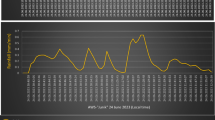Abstract
Nowadays, the nested grid model is widely used to increase the resolution of numerical model. An attempt to investigate the influence of the newly developed nesting technique of WRF model on the mesoscale numerical simulation of severe storm is described in this article. The results of sensitivity tests infer that the WRF model give more accurate and vivid prediction of severe storm with nesting scheme. As is shown in the tests, simulating value of the precipitation centers using nesting scheme are larger than those without using nesting scheme, which indicates that the simulating precipitation of nested storm is closer to the real rainfall. And there is obvious improvement of distribution of rain area and position of precipitation centers. According to the high resolution output data of the WRF model, deep and detailed analysis of characters of the mesoscale system that triggers the rainstorm is reported in this article, and the thermal and dynamical characters of this Meiyu front severe storm are also discussed.
Similar content being viewed by others
References
KIYAMA T. Large synoptic and mesoscale variations of the bai-u front, during July, 1982, Patr I: cloud feature [J]. J. Met. Soc. Japan, 1989, 67(1): 57–81.
CHEN S. J., KUO Y. H., WANG W. et al. A modeling case study of the heavy rainstorms along the Meiyu front[J]. Mon. Wea. Rev., 1998, 126(9): 2330–2351.
LIU Li-ping, RUAN Zheng, QIN Dan-yu. Case studies on mesoscale structures of heavy rainfall system in the Yangtze River generated by Meiyu front[J]. Science in China, Ser. D, 2005, 48(8): 217–225.
LIU Hua-qiang, QIAN Yong-fu. Numerical simulations of intense Meiyu rainfall in 1991 over the Changjiang and Huaihe River Valleys by a regional climate model with p-σ incorporated coordinate system[J]. Advances in Atmospheric Sciences, 1999, 16(3): 395–404.
WANG Chun-ming, WANG Yuan, WU Rong-sheng. The effect of model horizontal resolution on quantitative precipitation forecast for Meiyu front torrential rainfall[J]. Journal of Hydrodynamics, Ser. A, 2004, 19(1):71–83. (in Chinese)
CHENG Lin-sheng. Mesoscale atmosphere numerical model and simulation[M]. Beijing: Meteorology Press, 1994, 349–350. (in Chinese)
ZHANG Guo-cai. Progress of Weather Research and Forecast (WRF) model and application in the united states[J]. Meteorological Monthly, 2004, 30(12): 27–31. (in Chinese)
SUN Jian, ZHAO Ping. Simulation and analysis of three heavy rainfall processed in 1998 with WRF and MM5 [J]. Acta Meteorologica Sinica, 2003, 61(6): 692–700. (in Chinese)
ZHANG Fang-hua, MA Xu-lin, YANG Ke-ming. Numerical simulation and diagnositic analysis of a heavy rainfall in Jiangnan Area during 24–25 June 2003[J]. Meteorological Monthly, 2004, 30(1): 28–33. (in Chinese)
BI Bao-gui, JIAO Hai-yan, LI Ze-chun. Contrast analysis of meteorological and hydrological features of extremely heavy rainfall causing severe floods in Huaihe River valley [J]. Journal of Nanjing Institute of Meteorology, 2004, 27(5): 577–586. (in Chinese)
ZHU Gen-qian, SHOU Shao-wen. Principle and method of synoptic meteorlogy[M]. Beijing: Meteorology Press, 1992, 453. (in Chinese)
LU Han-cheng, YANG Guo-xiang et al. Mesoscale synoptic principle and prediction[M]. Beijing: Meteorology Press, 2000, 61. (in Chinese)
Al-FALAHI Fadha Sh., WANG Yuan, TANG Jie. Importance of moist ambient and its helical enhancement effect to storm intensity [J]. Journal of Hydrodynamics Ser. B, 2004, 16 (6): 743–755.
WU Guo-xiong, Evolution of moist potential vorticity and slantwise potential vorticity[J]. Journal of Meteorology, 1995, 53(4): 387–405. (in Chinese)
Author information
Authors and Affiliations
Corresponding author
Additional information
Project supported by the National Natural Science Foundation of China (Grant No: 90411006).
Biography: WANG Shu-chang (1980-), Female, Ph. D.
Rights and permissions
About this article
Cite this article
Wang, Sc., Huang, Sx. & Li, Y. Sensitive Numerical Simulation and Analysis of Rainstorm Using Nested WRF Model. J Hydrodyn 18, 578–586 (2006). https://doi.org/10.1016/S1001-6058(06)60138-8
Received:
Published:
Issue Date:
DOI: https://doi.org/10.1016/S1001-6058(06)60138-8




